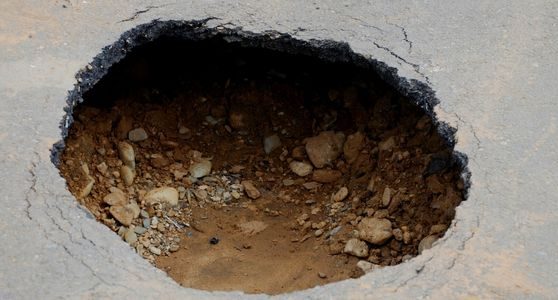Asphalt repair is essential for many reasons, but most importantly, to preserve your pavement and protect it from excessive deterioration. One of the most damaging pavement injuries are potholes. This article is an overview of various pothole repair methods. For a deep dive on what exactly a pothole is, how it is created, and how to fix and prevent it, visit our blog Asphalt Pothole Repair: Potholes Explained HERE.
Asphalt Patching Methods
Routine pavement maintenance is key in preventing serious pavement damages like potholes. When it comes to pothole repair, there are 3 basic asphalt patching methods used:
 Saw cut and patch – Just like it sounds, this method includes cutting and removing the areas of deterioration within the pavement to the appropriate depth and grade. After sawing and removal are complete, the clean new opening can be filled with hot mix asphalt. This results in a fairly permanent asphalt repair.
Saw cut and patch – Just like it sounds, this method includes cutting and removing the areas of deterioration within the pavement to the appropriate depth and grade. After sawing and removal are complete, the clean new opening can be filled with hot mix asphalt. This results in a fairly permanent asphalt repair.- Milling and patching – During the milling process, grinding the pavement’s surface occurs until the necessary depth is reached. The old millings go into a waiting truck to bring to a recycling center. This makes for an environmentally friendly option. The next step of this asphalt repair method is to add a new layer of asphalt pavement on top, carefully matching the thickness to the prior surface. Not only is this method friendly to the environment, but cost savings can be achieved by adjusting the depth of the milling repair.
- Infra-red patching – In this method, innovative machinery uses heat to soften the surface. This allows for it to be workable in any weather above 0 degrees. Because of this, infra-red patching allows for asphalt repairs to be performed through otherwise “off season” months. By heating up the pavement to a workable state, the machine allows for the new asphalt to fuse seamlessly to the old. This process eliminates the seam that is created by a saw cut and patch method, helping to further protect against damage associate with water penetration.
DIY Temporary Fix
Many DIY pothole filling methods include temporary cold or hot patches, or filling the hole with some sort of bagged gravel and compacting it. We do not recommend these DIY asphalt repair methods because they are a very temporary fix. Many people try these methods because they are simple, fast, and inexpensive. If you do choose one of these DIY pothole repair methods, it’s important to understand the temporary nature of this fix. We suggest having a paving professional inspect this area in the near future to formulate a more permanent fix!
Why The Urgency To Repair The Pothole?
 If a pothole is left untreated, it could lead to complete deterioration of your pavement requiring a new installation. Paving is a big investment, and because of this, it is important to regularly maintain it to ensure that you are getting the most out of your investment. Asphalt repair is the most cost-effective way to ensure that your driveway or commercial lot will last as long as it should. More importantly, potholes can be a safety hazard and failure to repair them can result in significant liability.
If a pothole is left untreated, it could lead to complete deterioration of your pavement requiring a new installation. Paving is a big investment, and because of this, it is important to regularly maintain it to ensure that you are getting the most out of your investment. Asphalt repair is the most cost-effective way to ensure that your driveway or commercial lot will last as long as it should. More importantly, potholes can be a safety hazard and failure to repair them can result in significant liability.
EastCoat Pavement Services can help you to formulate and put into place an asphalt repair and maintenance plan. We can also assist you in any other pavement needs you may have. We can install new pavement, sealcoat existing pavement, repair dangerous cracks and potholes, paint your lot, and more! In addition, we also will work with you during the planning phase to ensure that your tenants, employees, and/or daily traffic is taken care of and inconvenienced as little as possible! Contact EastCoat Pavement Services today for your free consultation and fill those pesky potholes today before winter hits!



 Saw cut and patch – Just like it sounds, this method includes cutting and removing the areas of deterioration within the pavement to the appropriate depth and grade. After sawing and removal are complete, the clean new opening can be filled with hot mix asphalt. This results in a fairly permanent asphalt repair.
Saw cut and patch – Just like it sounds, this method includes cutting and removing the areas of deterioration within the pavement to the appropriate depth and grade. After sawing and removal are complete, the clean new opening can be filled with hot mix asphalt. This results in a fairly permanent asphalt repair.